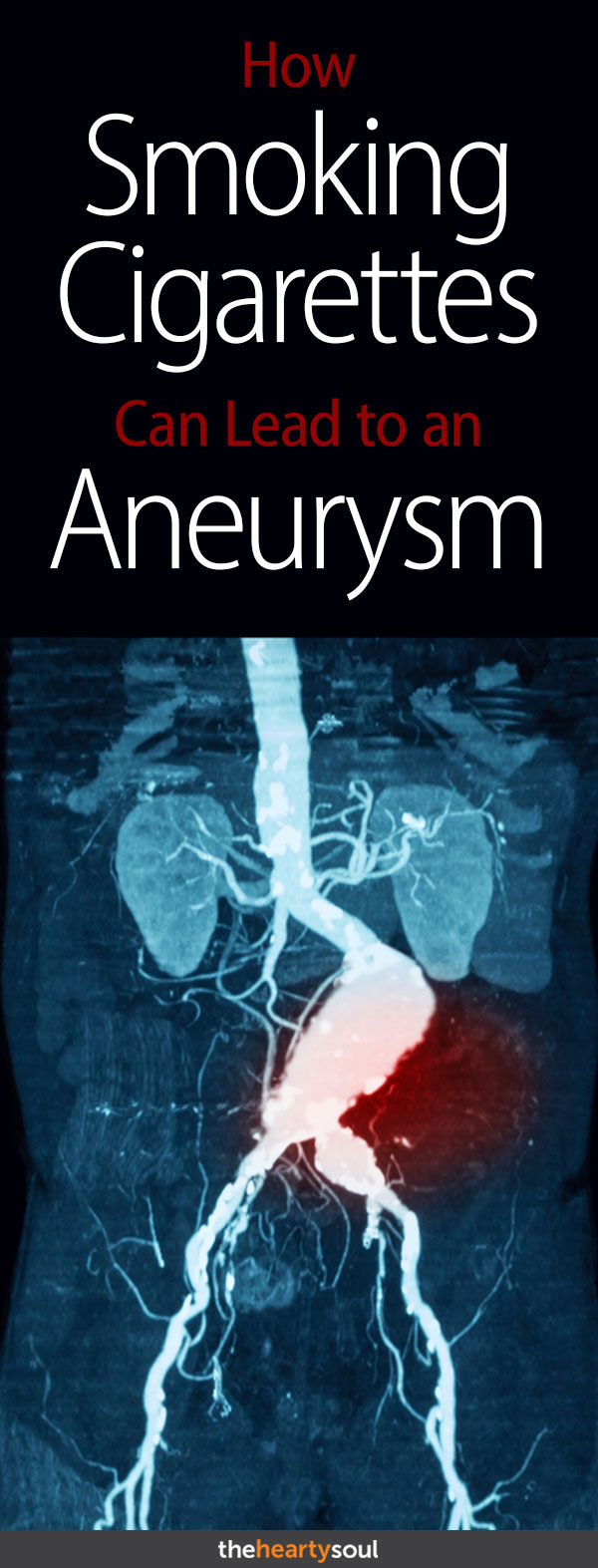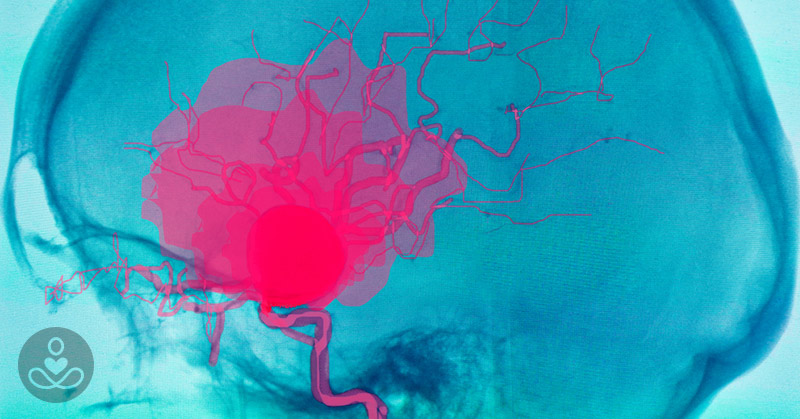People have been aware of the negative effects of smoking cigarettes for several decades now. But even with the decline of smoking that has followed since, there are still many people who choose to smoke. In 2016, 15.5% of adults in the U.S. smoked, which is an estimated 37.8 million people (1).
It is common knowledge that smoking causes lung cancer, but smoking has also been linked to (1):
- Coronary heart disease
- Emphysema
- Chronic bronchitis
- Reduced fertility
- Cancer in almost every part of the body
Aneurisms, both cerebral and aortic, are yet another health condition that cigarette smoking causes, though not many people think of aneurisms as a possible risk (2,3). The risk is, in fact, very real and aortic aneurysms were a contributing cause of 17,215 deaths in the U.S. in 2014 (4). Tobacco use is considered to be the most significant behavior related to aortic aneurysms and those who smoke are 3-5 times more likely to develop one (4).
Smokers are at an increased risk for developing aneurysms since smokers often have higher levels of cytokines, small secreted proteins that affect the communications and interactions between cells (5). Elevated levels of inflammatory cytokines have been found in patients with abdominal aortic aneurysms, suggesting causation. Inflammation caused by smoking cigarettes has proven to play a critical role in the development of cerebral aneurysms as well (2).
What Are Aneurysms?
Aneurysms are enlarged arteries caused by a weakness in the arterial wall (7). Often times they aren’t dangerous, however, cerebral aneurysms can be life-threatening (7). Cerebral aneurysms are located in the arteries that supply the brain with blood (7). They often cause subarachnoid hemorrhage strokes and can be fatal within 24 hours when they rupture (7).
Aortic aneurysms are another type of fatal aneurysm that are specifically located in the aorta, the artery that is responsible for carrying blood from the heart through the chest and torso (4). Aortic aneurysms can cause a dissection, where blood leaks between the split layers of the artery, or a rupture, where the aneurysm bursts completely and causes internal bleeding (4).
Smoking Cigarettes A Major Factor in Aneurysm Development
Studies have shown that females who smoke are just as at-risk, if not more, for developing abdominal aortic aneurysms than male smokers. Although, the reasons as to why are still unclear (2). Nevertheless, smoking is a major factor in whether or not a woman can develop an aneurysm (8).
A study conducted in the U.S. South on 18,792 participants over the age of 65 revealed that the difference smoking made was especially evident among women. Women who were former smokers had three and a half times the risk of developing an aneurysm than women who had never smoked. Current smokers had nine times the risk of developing a fatal aneurysm compared to women who never smoked (8). Evidently, quitting smoking makes a huge difference when it comes to the risk of developing an aneurysm.
How to Prevent an Aneurysm

Quitting smoking is the best way to prevent an aneurysm. With that said, quitting smoking is definitely easier said than done. Nicotine, the active ingredient in tobacco, is highly addictive, making it hard for smokers to quit permanently (9). Luckily, there are a number of nicotine replacement therapy options that can help you kick your habit.
Some of the best nicotine replacement therapies include:
- Nicotine patch: The nicotine patch works by giving you nicotine without the tobacco that comes in traditional cigarettes (10). It’s a great replacement therapy aid to use if you’re not quite ready to go cold turkey.
- Nicotine gum: Nicotine gum is another form of nicotine replacement therapy that replaces the stimulant (10). Chewing gum can keep you distracted from the fact that you’re trying to quit.
- Black pepper oil: If you want to avoid using nicotine patches or gum, using black pepper oil is a viable option. According to one group of Durham researchers from the Nicotine Research Center, inhaling black pepper oil actually helps suppress nicotine cravings without the withdrawal symptoms.
- Other ways to quit smoking and beat nicotine cravings
If nicotine replacement therapy doesn’t sound appealing to you there are also a number of nicotine free ways to quit smoking. Once you’ve kicked your habit, try to encourage those around you to quit smoking as well. Second hand smoke can cause some of the same health conditions associated with first hand smoke, especially when it comes to children (12).
The risk you take of developing serious health conditions, especially aneurysms, when smoking are simply not worth lighting up over. Remember, it’s never too late to quit and prevention is the best medicine.

Sources
- (1) Current Cigarette Smoking Among Adults in the United States. (2018, February 15). Retrieved from https://www.google.ca/search?q=statistics+on+people+who+smoke&rlz=1C5CHFA_enCA721CA721&oq=statistics+on+people+who+smoke&aqs=chrome..69i57.7447j0j7&sourceid=chrome&ie=UTF-8
- (2) Chalouhi, N., Ali, M.S., Starke, R.M., Jabbour, P.M., Tjoumakaris, S.I., Gonzalez, I.F., Rosenwasser, R.H., Koch, W.J., Dumont, A.S. (2012, October 27). Cigarette Smoke and Inflammation: Role of Cerebral Aneurysm Formation and Rupture. Mediators of Inflammation. Retrieved from https://www.hindawi.com/journals/mi/2012/271582/
- (3) Norman, P.E., Curci, J.A. (2013, May 16). Understanding the Effects of Tobacco Smoke on Pathogenesis of Aortic Aneurysm. Arteriosclerosis, Thrombosis, and Vascular Biology, 33. Retrieved from https://atvb.ahajournals.org/content/atvbaha/33/7/1473.full.pdf
- (4) Aortic Aneurysm Fact Sheet. (2016, June 16). Retrieved from https://www.cdc.gov/dhdsp/data_statistics/fact_sheets/fs_aortic_aneurysm.htm
- (5) Zhang, J.M., An, J. (2009, November 30). Cytokines, Inflammation, and Pain. International anesthesiology clinics, 45 (2), 27-37. Retrieved from https://www.ncbi.nlm.nih.gov/pmc/articles/PMC2785020/
- (6) Juvonen, J., Surcel, H.M., Teppo, A.M., Bloigu, A., Syrjala, H., Airaksinen, J. Leinonen, M., Saikku, P. Juvonen, T. (1997, November). Elevated circulating levels of inflammatory cytokines in patients with abdominal aortic aneurysm. Arteriosclerosis, thrombosis, and vascular biology, 17 (11). Retrieved from https://www.ncbi.nlm.nih.gov/pubmed/9409264
- (7). MacGill, Markus. (2017, November 28). Causes and treatments of aneurysm. Retrieved from https://www.medicalnewstoday.com/articles/156993.php
- (8) Kennedy, M. (2015, January 15). Women smokers may have same risk for deadly aneurysm as men. Retrieved from https://www.reuters.com/article/us-health-smoking-aneurysm-women/women-smokers-may-have-same-risk-for-deadly-aneurysm-as-men-idUSKBN0KO2GB20150115
- (9) Tobacco, Nicotine, and E-Cigarettes. (2018, January 5). Retrieved from https://www.drugabuse.gov/publications/tobacco-nicotine-e-cigarettes/nicotine-addictive
- (10) How to Quit Smoking. (2018, April 20). Retrieved from https://www.webmd.com/smoking-cessation/quit-smoking#3
- (11) Boseley, S. (2015, April 21). E-cigarette users trying to quit smoking should vape every day, studies suggest. Retrieved from https://www.theguardian.com/society/2015/apr/21/ecigarettes-giving-up-smoking-research-nicotine
- (12) Health Effects of Secondhand Smoke. (2018, January 17). Retrieved from https://www.cdc.gov/tobacco/data_statistics/fact_sheets/secondhand_smoke/health_effects/index.htm

